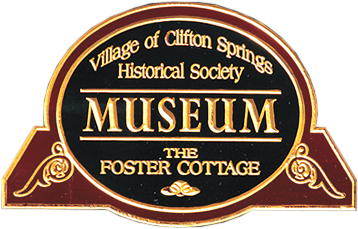Bath Treatments at "The Clifton Springs Sanitarium" ~ Part 2
By Jim Conners, Village Historian
Imagine a place where they put people up against a wall and spray them with 98 to 105 degree water and then with cold water down
to 70 degrees or less. A place where they put people into a tub with water then turn on an electro current to plates under the neck and feet. Or
after spraying a person with 100 to 105 degree water they are rubbed down with wet salt until the skin shows a good glow. And these people pay to
have this done to them. These are all part of the medical treatments that were done at the Clifton Springs Sanitarium. For those of you that are
new to the village I am sure that when you hear the name sanitarium different definitions of the word come to mind, the word sanitarium actually
means "a building for patients". When you here about the "treatments" as described above it is hard to think of the Clifton Springs Sanitarium as
a health resort where people came from all over the world for healing, rest and rejuvenation. The use of hydrotherapy is the application of water
in any form, either externally or internally, in the treatment of disease and the maintenance of health. . The use of hydrotherapy was the center
of the original Clifton Springs Water Cure founded by Dr. Henry Foster in 1850. The baths used for medical treatments began with the sulphur baths
because of the healing capabilities of sulphur water, which were plentiful here. As new practices in the science of hydrotherapy evolved so did the
types of baths prescribed to patients by their physicians. By the 1880's there were 20 variations of baths being offered to patients as part of their
treatment along with diets and exercise. Some of the baths listed were: Sponge, Pack, Health Lift, Falling Douche, Pail Dash. Turkish Bath, Air Bath,
Sulphur, Sitz, Vapor Bath, Electro-Thermal, Electro-Chemical, Compound Oxygen, Battery, and Foot. In the 1880's the patient was given a ticket from
the physician indicating which bath was prescribed, at which hour it was to be taken, at what temperature and for how many minutes.
This "ticket" came with a list of "RULES For BATHING" for the patient:
Reading the "General Instructions for Treatments" booklet, we get a glimpse of the information about the baths operations. This small booklet states:
"Those giving baths found that there first duty was to thoroughly familiarize themselves with the details of each treatment, so that upon receipt
of an order they may know how to carry out the prescription perfectly." (It talks about what we now call bed-side manner) "Many persons are
afraid of electricity in any form and great care should be exercised in the administration of electrical treatments. The patient should be
re-assured and only the mildest currents used, until their confidence has been gained, when the current may be increased gradually until the
prescribed limit has been reached, but this limit must not be exceeded under any circumstances. Special mention is made of the necessity of
polite attention and a sympathetic manner in dealing with each patient, showing no partiality or preference, but doing the utmost for each case,
thus insuring the good will and hearty appreciation of all efforts, and a ready response to the treatment given. Your personal influence will
count for or against the speedy recovery of every patient."
In the next article I will continue on with information about the baths.
